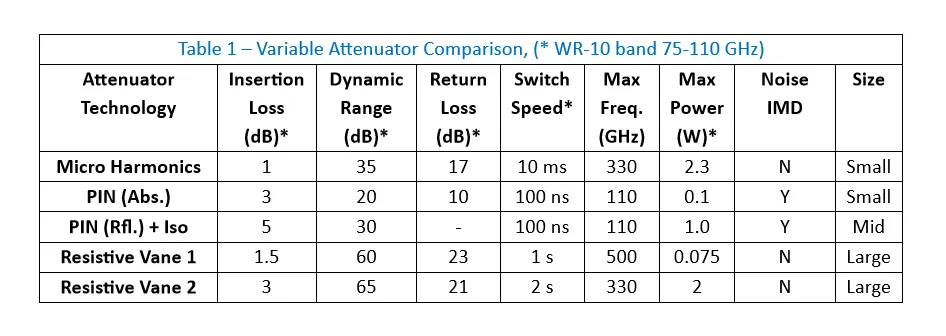A Comparison of Millimeter-Wave Variable Attenuator Technologies
Electronically tunable variable attenuators are useful for signal leveling and switching applications. The desirable characteristics of an attenuator are typically high power handling, high dynamic range, high return loss (low port reflections), a high degree of flatness in the response across the band, low insertion loss, and broad bandwidth. Size, weight, switching speed, and intermodulation distortion (IMD) can also be important figures of merit.
The two primary technologies used for variable attenuation in the mm-wave are PIN diode and resistive vane. A variable bias voltage applied to PIN diodes creates a variable loss mechanism. Resistive vane attenuators employ a mechanical actuator to gradually introduce a resistive vane into a waveguide.
PIN attenuators are available up to the WR-10 band (75-110 GHz) with 100 ns switching speeds. They are relatively compact and require only TTL level control signals. The PIN devices are available in a reflective mode or an absorbing mode. In the WR-10 band, the reflective mode PIN devices are advertised with “typical” 30 dB isolation, 1 W maximum power, and 4 dB insertion loss. Reflective mode attenuators do not absorb the blocked signal but rather reflect it back toward the upstream source. They can be used in series with an isolator that absorbs the reflected signal and protects the upstream source. The isolator adds additional insertion loss in the signal path so that the total insertion loss of the isolator and the PIN attenuator can easily exceed 5 dB in the WR-10 band.
The absorptive mode PIN attenuators have a 20 dB “typical” attenuation, 3 dB insertion loss, and a maximum power rating near 100 mW in the WR-10 band. The power rating of the absorptive PIN diode attenuator is much lower than the reflective type because the absorbed signal power generates heat. PIN diode attenuators can be used as switches by alternating between the minimum and maximum attenuation values. However, in the WR-10 band, the dynamic range is only about 20 dB (the difference between the insertion loss and the maximum attenuation setting). The PIN diode attenuators tend to have high port reflections approaching -10 dB. They are sensitive to damage from electrostatic discharge (ESD). PIN diode attenuators can also generate noise and harmonic content including intermodulation distortion products (IMD).
PIN diode chips covering the 110-170 GHz and 180-240 GHz bands have been reported. The chips have a maximum power rating of 10 mW, 22 dB maximum attenuation, and 2:1 VSWR (10 dB return loss). The insertion loss is 3 dB in the 110-170 GHz band and 5 dB in the 180-240 GHz band. We have not seen these chips packaged in a waveguide attenuator.
Electronically tunable resistive vane attenuators are large, heavy, and slow compared to PIN devices. But they have a much flatter frequency response and significantly higher dynamic range. The resistive vane attenuators are useful in lab environments but are unsuitable for many fielded systems. They employ calibrated control circuits and motor driven actuators to precisely position a resistive vane within a waveguide. We surveyed two distinct product lines. One line had attenuators up to the WR-2.2 band (330-500 GHz). The WR-10 model has an insertion loss of 1.5 dB, 65 dB dynamic range, one second switching speed, and a maximum power rating of 75 mW. The second line had models up to the WR-3.4 band (220-330 GHz). The WR-10 attenuator has an insertion loss of 3 dB, 65 dB dynamic range, two second switching speed, and a maximum power rating of 2 W.
Micro Harmonics Corporation (MHC) is developing a third technology that uses a Faraday rotator to rotate the RF signal polarity into a fixed resistive layer embedded in a ceramic cone. This is similar to the resistive vane technology but without moving parts. The new MHC attenuators have some unique characteristics that make them attractive options for mm-wave applications.
First, the MHC technology is passive which makes it insensitive to ESD damage. The MHC attenuators have a frequency response that is flatter than the PIN attenuators but not as good as the resistive vane devices. The dynamic range of the MHC WR-10 attenuator (35 dB) is higher than the PIN attenuator (20 dB). The MHC and PIN attenuators are much smaller and lighter than the resistive vane devices. The MHC attenuator can be scaled to at least 330 GHz while the PIN attenuators are currently limited to around 110 GHz.
The power rating for the MHC WR-10 attenuator (2.3 W) is comparable to the heavier duty resistive vane attenuators (2 W) and significantly higher than the PIN attenuators (100 mW). Port reflections for the MHC attenuator are typically less than -17 dB which compares favorably to the -10 dB reflections in the PIN devices. The insertion loss of the MHC WR-10 attenuator (1 dB) is less than the resistive vane attenuators (1.5-3 dB) and the PIN diode attenuators (3-5 dB). The MHC attenuator switching speed (10 ms) is two orders of magnitude faster than the resistive vane (2 s) and five orders of magnitude slower than the PIN devices (100 ns). But Micro Harmonics is developing a next-generation Faraday rotation attenuator that could attain switching speeds in excess of 100 kHz (< 10 μs).
Table 1 gives a brief summary of the performance characteristics associated with the three types of mm-wave variable attenuators. Some of the data are specific to the WR-10 band. All three technologies are broadband, covering entire rectangular waveguide bands. All have strengths and weaknesses that must be evaluated for each particular application. The MHC attenuators are an attractive option since they combine some of the best attributes of the PIN diode and the resistive vane attenuator technologies.
Micro Harmonics is a leading provider of cutting-edge millimeter-wave components and solutions. With their expertise in variable attenuator technologies, they offer innovative products that enable precise control of signal power in advanced applications. If you have any questions about our products, feel free to contact us.

